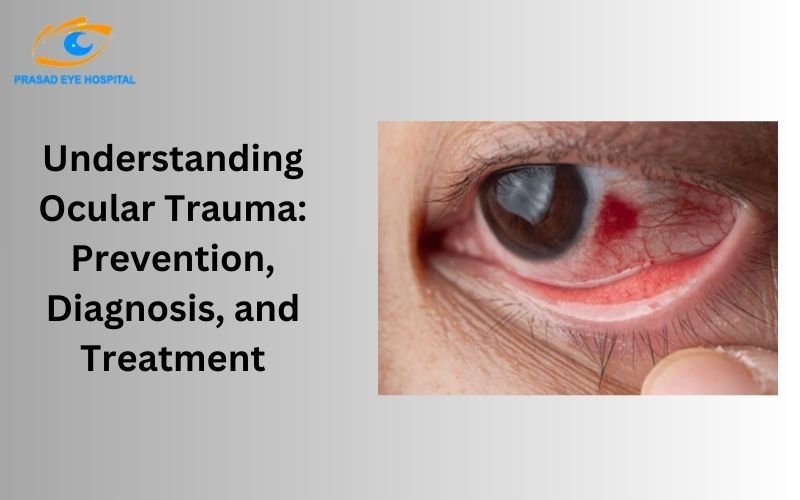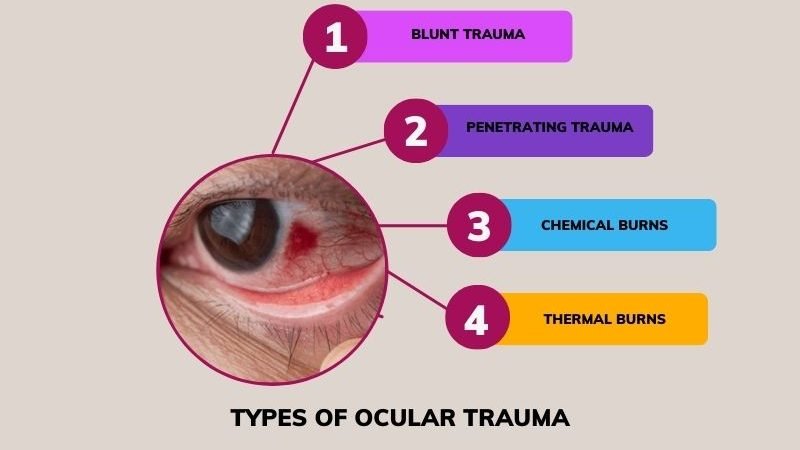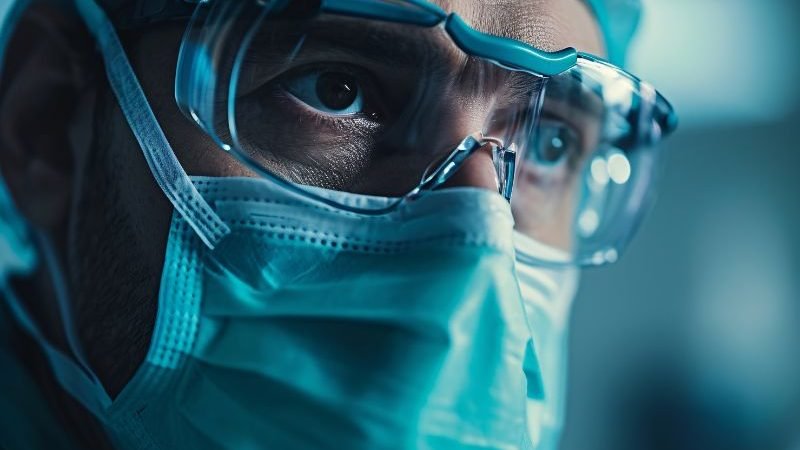
Introduction to Ocular Trauma
Ocular trauma refers to any injury to the eye and its surrounding structures. These injuries can range from minor abrasions to severe trauma that might threaten vision. At Prasad Eye Hospital in Ramgarh, Jharkhand, we understand the critical importance of prompt and effective management of ocular trauma to preserve vision and ensure overall eye health.
Types of Ocular Trauma

Blunt Trauma
Blunt trauma occurs when an object strikes the eye with force without penetrating it. This can cause various issues such as contusions, ruptures, or retinal detachments. Examples include sports injuries, accidents, or falls. Blunt trauma often results in symptoms like swelling, bruising, and significant pain. Studies show that sports-related injuries account for a significant number of ocular trauma cases each year, highlighting the need for protective measures (Source: American Academy of Ophthalmology).
Penetrating Trauma
Penetrating trauma happens when a sharp object punctures the eye. This type of injury can cause severe damage to the eye’s internal structures and may lead to vision loss if not treated immediately. Immediate medical attention is crucial to prevent complications and preserve vision. According to a study published in Ophthalmology, penetrating injuries can lead to long-term visual impairment if not addressed promptly.
Chemical Burns
Chemical burns result from exposure to harmful substances like acids or alkalis. These burns can cause extensive damage to both the surface and deeper tissues of the eye. Immediate irrigation with saline or water is essential to minimize damage and prevent serious consequences. Research indicates that timely irrigation can significantly reduce the severity of chemical burns.
Thermal Burns
Thermal burns occur from exposure to extreme heat, such as fire or hot liquids. These burns can damage both the external and internal parts of the eye. Specialized care is necessary to manage these injuries effectively and prevent long-term damage.
Causes and Risk Factors
Identifying common causes and risk factors associated with ocular trauma is crucial for prevention and early intervention.
- Accidents and Sports: Activities like contact sports, construction work, and recreational activities often involve a high risk for eye injuries. Data shows that approximately 40,000 sports-related eye injuries occur annually in the United States (Source: American Academy of Ophthalmology).
- Occupational Hazards: Professions such as welding, woodworking, and manufacturing expose workers to potential eye injuries. Safety measures, including the use of protective eyewear, are essential in these environments.
- Domestic Injuries: Household items and cleaning chemicals can also cause eye injuries. Using safety goggles when handling chemicals and being cautious with sharp objects can help reduce the risk.
Symptoms and Diagnosis
Recognizing the symptoms of ocular trauma and seeking prompt medical evaluation are vital.
- Common Symptoms: Symptoms may include pain, redness, swelling, vision changes, and light sensitivity. Severe cases might involve bleeding or the protrusion of the eye.
- Diagnostic Procedures: A comprehensive eye examination is necessary for accurate diagnosis. This may include visual acuity tests, slit-lamp examinations, and imaging studies like ultrasound or CT scans. Early diagnosis is crucial for determining the appropriate treatment.
Treatment and Management
Effective treatment of ocular trauma involves immediate first aid and professional medical care.
- Immediate First Aid: For minor injuries like foreign bodies in the eye, flushing with clean water can help remove debris. Avoid rubbing the eye to prevent worsening the injury.
- Medical Treatments: Treatments may involve medications for pain and inflammation, as well as topical antibiotics to prevent infection. For chemical burns, immediate irrigation with saline or water is critical.
- Surgical Interventions: Severe injuries might require surgical intervention to repair damaged tissues or restore vision. Options can range from minor procedures to more complex surgeries, depending on the injury’s severity.
- Long-Term Management: Post-treatment care may include follow-up visits to monitor healing and address complications. Rehabilitation, including vision therapy, may be necessary to improve visual function.
Prevention Strategies

Preventing ocular trauma involves proactive measures to protect the eyes.
- Safety Measures: Use protective eyewear during activities with a high risk of injury. Safety goggles or face shields are essential for protecting against impacts, chemicals, and other hazards.
- Protective Gear: For specific activities like sports or construction, appropriate protective gear can significantly reduce the risk of injuries. Ensuring that safety equipment is properly fitted and used consistently is key.
Why Choose Prasad Eye Hospital
- Expert Care: Our team, led by Dr. Indranath Prasad, offers specialized treatment for ocular trauma with extensive experience and expertise.
- Advanced Technology: We use cutting-edge diagnostic and surgical technology to ensure precise and effective treatment.
- Personalized Treatment: Each patient receives an individualized care plan tailored to their specific needs and conditions.
- Comprehensive Services: From emergency care to long-term follow-up, we provide a full range of eye care services.
- Compassionate Approach: We prioritize your comfort and well-being, offering a supportive and caring environment.
- Convenient Location: Located in Ramgarh, Jharkhand, we offer easy access and flexible appointment times.
- Proven Results: Our track record of positive outcomes and patient satisfaction reflects our commitment to quality care.
Book an Appointment
Booking an appointment at Prasad Eye Hospital is easy and convenient. You can schedule your visit online by visiting our website at Prasad Eye Hospital, where you can choose a suitable date and time. If you prefer, you can also visit our hospital in Ramgarh, Jharkhand, to book an appointment in person. Our team is ready to assist you with any questions and ensure a smooth scheduling process. We look forward to providing you with exceptional care.
